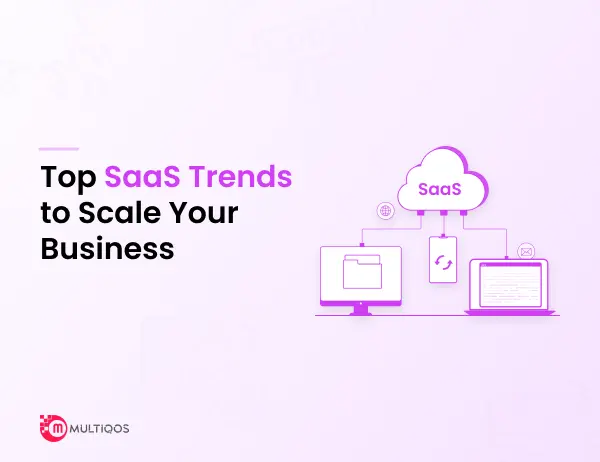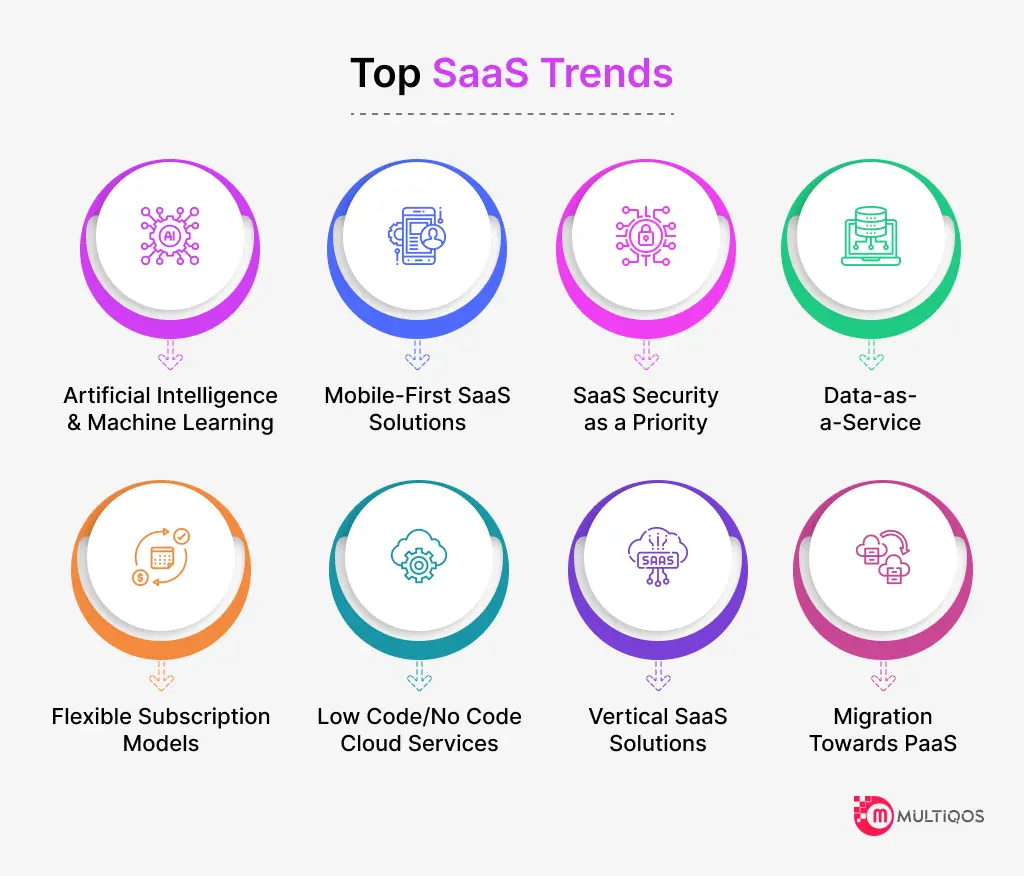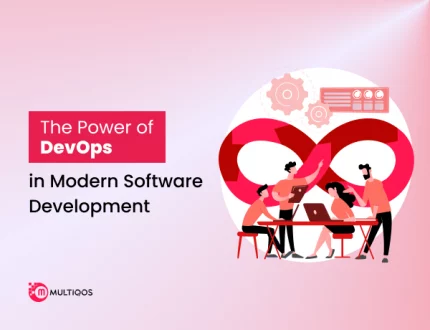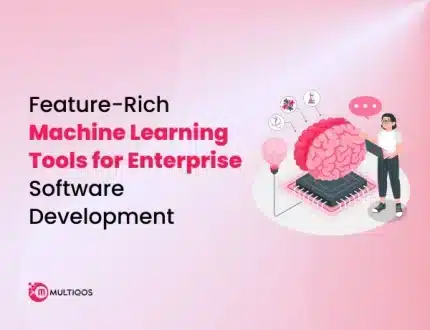Top SaaS Trends in 2025: Unleash the Innovation

Table of Contents:
The development of the SaaS (Software as a Service) industry has been very fast, reshaping business operations with innovative technologies and trends. SaaS provides users with access to software applications around the globe via the internet, in contrast to local installation or maintenance.
According to Gartner, the SaaS market is anticipated to surpass USD 232 billion by 2025. The increasing number of companies transitioning their IT requirements to the cloud has positioned SaaS software as a critical tool for businesses of all sizes within every industry.
Its flexibility, scalability, and cost-efficiency drive swift adoption, removing the need for expensive hardware investments and internal IT resources. SaaS enables rapid deployment, seamless upgrades, and predictable expenses with usage-based billing.
Indeed, more than 91% of organizations view SaaS as an enabler for adopting emerging technologies. Major software vendors transition to cloud-based services, while startups disrupt markets with innovative SaaS apps.
The SaaS model fosters digital transformation across organizations, enabling them to stay competitive in an evolving landscape. Let’s explore further the innovations that will reshape how organizations utilize the cloud to boost productivity, collaboration, security, and beyond.
Artificial Intelligence and Machine Learning
AI and ML are the two concepts that are leveraging upon significant developments in recent years. AI and machine learning are currently progressing very fast, which is ready to revolutionize SaaS capabilities in 2025.
AI and ML will become integral parts of the solutions that SaaS companies offer since they allow developers to provide more predictive features, personalized experiences, and automation tools for users. Several key trends will drive the adoption of AI/ML in SaaS:
-
- Predictive analytics: AI algorithms can be called to perform tasks they already know by identifying valuable trends in data to make forecasts and suggestions. SaaS platform providers would develop predictive analysis and suggest actions aligned to user requirements.
- Intelligent automation: ML tools like NLP permit software to dispense with all the tedious jobs and pay more attention to other more important issues. SaaS products are expected to help improve efficiency through intelligent automation by reducing the space for mundane and repetitive work.
- Personalization: AI drives the effect of hyper-individualization, which enables commands that correspond to each user’s singular interests. SaaS apps will bring one-of-a-kind experiences, content recommendations, and workflows for all individuals, and they will be personalized in some way.
- Chatbots and virtual assistants: Conversational chatbots paired with AI facilitate human interaction with SaaS software apps. Intelligent virtual assistants can deal with customer support, user education and advice, and tips.
With AI and ML integration, SaaS provides a way to present value to the customer with actionable insights, personalized experiences, and automated workflow. The capacity of SaaS to produce intelligent outputs will be growing multifold in the next few years as machine learning and artificial intelligence (ML/AI) will become an integral part of the systems.
Mobile-First SaaS Solutions
Mobility is another big factor in this growth as more and more users accessing the SaaS solutions through mobile devices is propelling greater demand for mobile-friendly SaaS solutions. Nowadays, mobile devices such as smartphones and tablets are turning into the primary tools for people to work, shop, socialize, and entertain.
Such will translate into the need for SaaS vendors to make their solutions and user experience mobile-device-friendly as a top priority. Along with mobile apps, as well as mobile-adaptable websites are an important part of standard SaaS platforms.
Mobile Internet traffic already outruns that of desktops, so SaaS websites should offer easy user interfaces on any device. SaaS systems inaccessible to mobile are more likely to frustrate users and lose out to competitors that can provide data anytime, anywhere.
The primary spots to look at shall include mobile apps with offline access, AI-driven mobile experience, one-tap cloud syncing across devices, and the integration of mobile with collaboration tools, in particular. SaaS vendors with their Mobile access clout will have a marked competitive edge as the trend of work mobility heightens.
SaaS Security as a Priority
Be it data breaches or privacy violations regularly filling the news it happens now in every SaaS provider that the security and compliance are being put above everything. Users of SaaS tools dislike giving away their data and expect to be assured that the data will be secure.
The increasing quantity and complexity of cyber threat issues turns them into a mandatory issue today. Information theft through phishing, malware, and other sorts of attacks can penetrate even the most secure SaaS infrastructure.
Because these remote and diffuse teams are now using the SaaS app, the providers have to make access possible from any part and yet keep the information secured.
To satisfy customer demands and remain compliant, leading SaaS providers are taking steps like:
-
- Security training for development teams generating safe applications and codes.
- Vulnerability scoping during the development cycle automatically
- Multi-factor authentication and access controls for customers with advanced privacy parameters.
- Encryption for data while in transit and while in storage.
- A defined program that includes response profiles, breach isolation suspect data and strings, and lessens the severity of the breach.
Data-as-a-Service (DaaS)
As data is currently one of the most precious resources a business has, companies are investing vast amounts of money to collect and store as much data as possible from as many sources as they can find.
The DaaS or the Data-as-a-Service is the area where these multitudinous data must be aggregated and generally sorted out before analysis.
DaaS allows for quick and immediate access required for data and insights without the paid upfront costs to achieve the same. IoT organizations can use DaaS to analyze their data easily in a determinable time and make data-driven decisions in real-time.
DaaS enables businesses to do the right thing, using sensitively handled data and cope with data storage, governance, and analysis issues.
Some key benefits of Data-as-a-Service include:
-
- Faster time to insights: As data storage and processing is the responsibility of the service provider, companies can therefore focus on Only the process of analyzing data and drawing conclusions.
- Flexibility and scalability: Through DaaS, users gain the ability to implement sophisticated analytics quickly and non-technical persons are more willing to use data science.
- Democratized access to data: Now, not only the IT department, but any employee can call upon data and insight to respond to queries through a user-friendly interface. This distributes and equalizes the reporting, user-friendly, and inventory data usage among the workforce across the organization.
As data will keep playing a more significant role, stand by for more companies to apply DaaS-supported data analytics for unrestricted growth and scalability. At the forefront of tomorrow’s data-driven business world, the capability to fast-crunch raw data to insights will be an essential advantage.
Migration towards PaaS
Today, Platform-as-a-Service (PaaS) is a widely known trend in SaaS providers. PaaS does this through a delivery framework and tools for building, running, and managing applications without a need for the development of the underlying infrastructure.
A lot of SaaS companies are building on top of the IaaS model to switch to PaaS. This transformation makes it possible for them to make use of their knowledge by creating innovative products or services without worrying about server management or runtime applications.
Key benefits of migrating SaaS to PaaS include:
-
- Faster development cycles: PaaS features a set of instruments for code building along with API tools for faster delivery of new features. The support that SaaS providers bring to market can make them able to launch their products faster.
- Operational efficiencies: PaaS compresses much of the DevOps jobs into fewer tasks, thus fewer engineers are taken up. Organizations can reduce expenses and outlay.
- Security and compliance: Many of the prominent PaaS providers have impeccable security standards and compliance features directly implemented in the service.
- Access to advanced technologies: Specifically, PaaS helps businesses to take advantage of old technologies such as AI and blockchain in their SaaS platform.
With the further progress of SaaS, PaaS stays at the core part of the service supply as the technology assists companies to concentrate their efforts on product development without IT operations management. SaaS to PaaS migration will speed up the prototyping and unchain the age of new and effective SaaS products.
Flexible Subscription Models
The SaaS market trending huggers of the traditional, strict, and customized subscription models as flexible plans are getting adopted. This results in providers being able to cater to specific customers’ needs despite varying demands. Some key trends in SaaS subscription models include:
-
- Per-user pricing (the one popular at present) is the one where a company is charged per user or seat, seeing as it is the one that provides accurate cost and value. This per-user pricing slowly adjusts to pay-per-use without switching pricing plans.
- All-feature-oriented packages – In a bid to provide customers with value for their money, bundled offers into different packages or editions are the order of the day. This is the right kind of approach for those whose key business has chosen the features. Those such as base level, professional, and enterprise, match up with separate demands.
- Subscription plans tailored specifically – The customers have the option to select automatically the features they require, integrations, and support levels including terms of the subscription. Flexibility in this feature is the factor that impacts the rightness of the need.
- Flexible options – Customers have the choice between monthly, quarterly, or yearly subscriptions, which effectively lead to a lower amount of wastage in case customer’s requirements change.
- Free trials/freemium models – The increasing number of providers offering free tiers/ trials are the ones who help to downscale barriers and gain users.
SaaS models, where there is more flexibility in economics, lead to an attempt at experimenting with subscriptions as a viable business model. We all benefit from having choices and the option to plan our payments to SaaS according to our individual needs.
Vertical SaaS Solutions
Vertical SaaS is a niche approach that tackles the needs of a specific industry such as healthcare, real estate, finance, or retail industry. On the other hand, horizontal SaaS is for all companies in general. These solutions are tailored to satisfy, within their industrial interactions and workflows, what is specific to that kind of industry.
As the example of SaaS developed for hospitals, this will be crafted to contain the features relevant specifically to the healthcare sector including electronic medical records, insurance claims, and scheduling.
One of the interesting advantages of vertical SaaS is the ability to have industry-specific, custom-designed solutions rather than having universal solutions. Thus, the provider gives the software an industry-good practice implementation, as well as the specialized terminology needed.
To summarize, vertical SaaS releases innovation by enlisting industry-specific needs during the software development and design work. The development of SaaS solutions allows companies to improve productivity and efficiency by focusing on the niche and targeted areas.
Low Code/No Code Cloud Services
Low code/no code tools will remain to burst onto the SaaS market in the upcoming year of 2025. These interfaces permit non-technical and also developer-level users to build cloud-based applications using a drag-and-drop approach or by employing logic flows contradicting traditional coding.
Some key benefits of low code/no code platforms include
-
- Faster app development. As development time is reduced, companies no longer need to spend months prototyping and building applications but hours or days using low-code/no-code platforms.
- Improved productivity. According to studies, an increase in productivity of low code/no code platforms from around 5x to 10x is possible. Developers can now build highly capable stand-alone apps even without much code, allowing them to instead focus on more complex challenges.
- Cost savings. Low or no code diminishes the necessity of the big engineering teams and high developmental expenses. You can build and modify apps with ease and at a relatively lower cost compared to big budgets that are coming along with it.
- Cloud-native benefits. The front runners of this low code/no code cloud platform are built to operate within the cloud itself. It helps companies release applications more quickly and easily across platforms while offering the ability to easily scale, global deployment, built-in cloud services integration, and automatic updates.
As we see low code/no code maturity passes, we can expect them to grow the capabilities of the platforms. Organizations that are swift to use low-code/no-code development will have a much bigger chance of being fast in experimentation, innovation, and adapting to customers’ dynamic needs, which in turn will give them the edge in the competition.
Why Choose Us as an Innovative Business Solution that can Help You to Grow?
The SaaS industry has the potential to be dynamic, and it becomes critical for companies to adapt themselves to the recent trends to remain competitive in the sector. The forward glance of 2025 brings to light the brisk nature of innovation in the SaaS (Software-as-a-Service) industry.
There will be AI involvement and data confidentiality will be an issue, as SaaS gaming companies will be eyeing the market and modifying the terrain in the sector. Alongside these trends, MultiQoS is a leading saas app development company that introduces new avenues of invention and involves existing best practices for the industry.
To be able to reduce their operation procedures and to create responses that are friendly to customers, companies have started to embrace SaaS along with MultiQoS, which is one of the leaders of the digital transformation cycle. Let’s connect with us to stay ahead of the curve and unleash the full potential of your business in the world of SaaS and beyond.
FAQ on Top SaaS Trends in 2025
SaaS offers flexibility, scalability, and cost-efficiency, enabling businesses to adapt quickly to changing needs without heavy investments in infrastructure.
The SaaS market is projected to experience significant growth, with forecasts estimating it to surpass $232 billion by 2024, driven by increasing adoption across various industries.
The two major categories of SaaS are vertical SaaS and horizontal SaaS, with vertical SaaS focusing on specific industries and horizontal SaaS offering general solutions across industries.
Industries such as healthcare, education, finance, accounting, retail, and many others are driving the growth of SaaS by adopting cloud-based solutions to enhance operations and efficiency.
One category of SaaS applications is Data-as-a-Service (DaaS), which provides data-centric solutions for various tasks and outcomes, contributing to the growth and innovation in the SaaS industry
Get In Touch







